Mercury City Tower
Mercury City Tower (Russian: Меркурий Сити Тауэр, tr. Merkuriy Siti Tauer) is a supertall skyscraper located on plot 14 in the Moscow International Business Center (MIBC) in Moscow, Russia. Occupying a total area of 173,960 square metres (1,872,500 sq ft), the mixed-use building houses offices, apartments, a fitness center, and retail stores.[5][6]
| Mercury City Tower | |
|---|---|
Меркурий Cити Tауэр | |
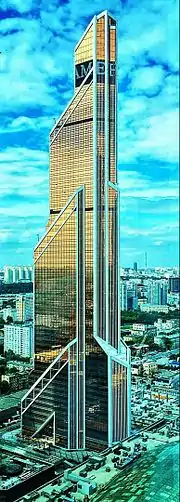 | |
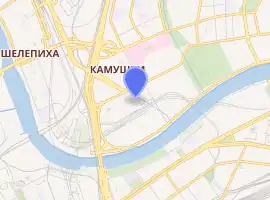
| |
| Alternative names | Mercury City, Mercury Office Tower |
| General information | |
| Status | Complete |
| Type | Mixed-use |
| Architectural style | Structural Expressionism |
| Location | Moscow International Business Center Moscow, Russia |
| Coordinates | 55°45′2″N 37°32′22″E |
| Construction started | 2006 |
| Completed | 2013 |
| Cost | US$1 billion |
| Owner | Igor Kesaev |
| Height | |
| Roof | 338.8 m (1,112 ft) |
| Technical details | |
| Floor count | 75 5 below ground |
| Floor area | 173,960 m2 (1,872,500 sq ft) |
| Lifts/elevators | 29 |
| Design and construction | |
| Architect | M.M. Posokhin Frank Williams and Associates G.L. Sirota |
| Developer | LLC Rasen Stroy |
| Structural engineer | Mosproject-2 |
| Main contractor | Rasen Construction |
| References | |
| [1][2][3][4] | |
Rising 338.8 m (1,112 ft) tall, the Mercury City Tower was formerly the tallest building of Russia and Europe, having surpassed the Moscow Tower of the neighboring City of Capitals complex (also in the MIBC) as the tallest of Russia and The Shard in London as Europe's tallest building.[7] The Mercury City Tower kept this record from late 2012 to the summer of 2014, in which it was surpassed by the South Tower of the neighboring OKO complex (also on the MIBC) as the tallest building in Russia and Europe.[5][6] Currently, it is the fifth-tallest building in Europe.
History
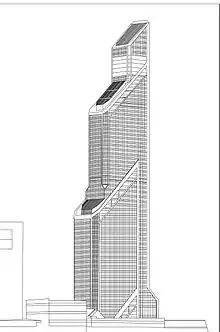
Mercury City Tower was jointly developed by the American architect Frank Williams and the Russian engineering team Mosproject-2 under the leadership of architect Mikhail Posokhin. After the death of Williams in 2010, the Russians were able to convince Dutch architect Erick van Egeraat to succeed him and thus finish Williams' work.[8]
Construction of Mercury City Tower began in 2006.[5][9] The project was estimated to be completed by 2009, but developers Mercury Development and Liedel Investments Limited preferred to slow down the project in order to not bring the building to the housing market during the Great Recession. By 21 April 2009, Mercury City Tower had just finished foundation work: finishing earthworks and five underground floors, and was ready for construction over ground. The estimated completion date was then pushed to 2010.[10]
On 1 November 2012, the Mercury City Tower topped out at 338.8 m (1,112 ft), overtaking the Moscow Tower of the neighboring City of Capitals complex as the tallest building of Russia and The Shard in London as tallest building of Europe.[5][7][11] It also became the world's tallest building built of reinforced concrete.[5]
Construction was finished in 2013.[5][6][9]
On the summer of 2014, the South Tower of the neighboring OKO complex surpassed the Mercury City Tower as the tallest building in Russia and Europe as well as the tallest building built of reinforced concrete.[5]
Construction was conducted with the help of a US$300 million loan from Sberbank, which created the ground for speculation about the possible transition of the building into ownership of the bank in 2015-2016. The loan was restructured in 2016. The whole cost of the project was estimated by business publications to range between US$650 million and US$1 billion.[12][13]
Design

Overview
The Mercury City Tower's distinctive copper-colored cladding makes the building stand out among its neighboring skyscrapers in the MIBC as well as the entirety of Moscow. The building was originally designed to be surfaced in reflective silver glass in order to mirror the buildings surrounding it, but this eventually was replaced by an equally reflective bronze-tinted glass. This gives the building a constant orange glow that makes it appear as it is embracing itself with the sunlight on the horizon. This was according to Egeraat in an interview with Arch.ru introduced by Egeraat's Russian colleagues. A media facede made of 2 million LEDs was installed on the exterior of the 67th and 68th floors of the building. Thus, the Mercury City Tower has the tallest media facade in Europe.[9][14]
The Mercury City Tower also has a unique setback shape, in which the building steps back twice along its northwestern facade, creating a tapering effect that extends the building's height in conjunction with the vertical skeletal striping that show its corners. Each setback has a slanted roof that supports the illusion of added height. For greater reliability, two independent reinforced concrete skeletons were provided to make the Mercury City Tower resistant against a 6.0 magnitude earthquake.[15] This as a result gives the building a futuristic and high-tech look, fitting it in the Structural Expressionist architectural style.[9][14]
After Williams' death on 25 February 2010, his successor Egeraat stated it would be improper to make significant changes to the tower and focused on improving the upper levels of the building, elaborating a functional solution for the skyscraper, and developing interiors of public spaces.[16]
Environmental
The building is claimed by architect Frank Williams as the first environmentally friendly building in Russia, since it was designed to collect melting snow water, as well as provide 70% of the workplaces with access to daylight. The building also features a smart “energy cycle” system that regulates energy usage, ambient temperatures, and hot water distribution throughout the development.[6][9]
Features
Mercury City Tower is a mixed-use building, featuring offices, apartments, retail, restaurants, a fitness center, conference rooms, and parking spaces.[5][6] The apartments are located on the topmost floors of the building, and was designed to merge units, adding to the tower’s overall space efficiency.[9]
The building has a total of 29 elevators, in which two of them are high-speed elevators travelling at a maximum speed of 7 m/s. Out of the 29 elevators, 20 are passenger elevators and 9 are service elevators. 10 of the passenger elevators operate with the TWIN system.[6]
Construction gallery
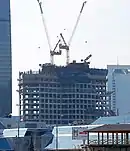 March 2010
March 2010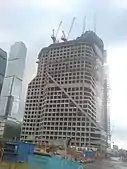 August 2010
August 2010 November 2010
November 2010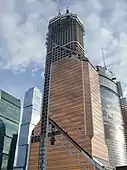 August 2011
August 2011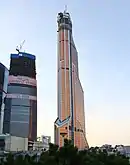 October 2012
October 2012
References
- "Mercury City Tower". CTBUH Skyscraper Center.
- Mercury City Tower at Emporis
- "Mercury City Tower". SkyscraperPage.
- Mercury City Tower at Structurae
- "Mercury City Tower, Moscow". SkyscraperPage.com. Retrieved 25 September 2010.
- Emporis GmbH. "Mercury City Tower, Moscow, Russia". Emporis.com. Retrieved 25 September 2010.
- Ilya Khrennikov, 'Moscow Mercury City Tops Shard as Europe’s Tallest Tower', Bloomberg, 1 November 2012.
- "Меркурий-Сити Тауэр. Россия, Москва". Архи ру (in Russian). Retrieved 2018-06-23.
- "Mercury City Tower - The Skyscraper Center". www.skyscrapercenter.com. Retrieved 2018-06-23.
- "Завершен нулевой цикл строительства башни "Меркурий Сити"". РБК Недвижимость. Retrieved 2018-06-23.
- ctbuh. "Moscow Tower Overtakes The Shard". ctbuh. Archived from the original on 2018-12-31. Retrieved 2018-06-23.
- "Небоскреб "Меркурий" в "Москва-Сити" могут забрать за долги". РБК Недвижимость. Retrieved 2018-06-23.
- ""Меркурий" в безопасности: Игорь Кесаев договорился о реструктуризации кредита в Сбербанке | Бизнес | Forbes.ru". www.forbes.ru. Retrieved 2018-06-23.
- "Жизнь по вертикали". Дом. 2012-03-29. p. 5. Retrieved 2018-06-23.
- Makar, Dmitriev (September 2016). "The Supreme Mind". Vokrug Sveta. No. 9 (2912): 98–99. ISSN 0321-0669.
- "Эрик ван Эгераат: "Россия может добиться намного большего, как без международной поддержки, так и вместе с ней"". Архи Ру (in Russian). Retrieved 2018-06-23.
External links
| Wikimedia Commons has media related to Mercury City Tower. |
- Official website
- M.M. Posokhin, russian architect website
- Mosproject-2, russian architect agency's website
- Mosproject-2, the project on the russian architect agency's website
- The project on Frank Williams & Partners Architects LLP's website
| Records | ||
|---|---|---|
| Preceded by The Shard |
Tallest Building in Europe 2012—2014 338.8 m |
Succeeded by OKO South Tower |
| Preceded by City of Capitals Moscow Tower |
Tallest Building in the Former Soviet Union 2012—2014 338.8 m |
Succeeded by OKO South Tower |
| Preceded by City of Capitals Moscow Tower |
Tallest Building in Russia 2012—2014 338.8 m |
Succeeded by OKO South Tower |
| Preceded by City of Capitals Moscow Tower |
Tallest Building in Moscow 2012—2014 338.8 m |
Succeeded by OKO South Tower |